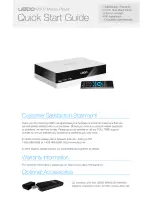
REVO
CDP
/
DS-1
/ DAC board
Optional
14
7 • Configurations
7.6 Analog filter setting
This parameter is not applicable in this unit.
7.7 De-emphasis control setting
This parameter is used to set the operation of de-
emphasis.
In OFF mode the de-emphasis is always OFF.
In ON mode to de-emphasis is always ON if the input
frequency is 44.1 KHz or 48.0 KHz.
In AUTO mode, the de-emphasis is enabled automatically
by the system when it detects the presence on the SPDIF
signal.
The de-emphasis is indicated by a dot flag in the display.
When it flashes, the de-emphasis is detected in the input
signal but NOT activated. When lit, the de-emphasis is
active.
Note:
The procedure for emphasis / de-emphasis is not very
common and has been used mainly in CD’s made in the 80’s.
However, we must consider that many burns software, and
many PC recording drives does not manage de-emphasis
information.
If a digital audio track sounds a bit too rich in high frequencies,
maybe because the emphasis flag was lost during the copy
of the track, you can manually enable de-emphasis.
Frequency response slow roll off
Fig. DAC 4
7.4 Direct down SRC setting
When Upsampler mode is active, you can select the
Direct Down mode.
Refer to page 69 of SRC4392 data sheet:
“ … Decimation Filter / Direct Down-Sampling Function
This bit selects the mode of the decimation function, either true
decimation filter or direct down-sampling without filtering.
Direct down-sampling should only be used when the output
sampling rate is higher than the input sampling rate. When the
output sampling rate is equal to or lower than the input sampling
rate, the Decimation Filter must be used in order to avoid aliasing… “
Note:
Remember, if you select the Direct Down mode and the
output sampling rate is equal to or lower than the input
sampling rate, the system automatically switches in Direct
Down = OFF.
7.5 Digital filter setting
You can select the digital filter in the two modes, SLOW
or SHARP:
• In SLOW mode, the response of the filter provides the
best performance and linearity for time response;
• In SHARP mode, the response of the filter provides the
best performance and linearity for frequency response.
For more information, please refer to the DF1706 data sheet, p.4.
Frequency response sharp roll-off
Fig. DAC 2
Passband ripple sharp roll-off
Fig. DAC 3
4
0
3
2
1
Frequency (f
S
)
20
0
–
20
–
40
–
60
–
80
–
100
–
120
–
140
–
160
–
180
–
200
FREQUENCY RESPONSE (Sharp Roll-Off)
Attenuation (dB)
4
0
3
2
1
Frequency (f
S
)
0
–
20
–
40
–
60
–
80
–
100
–
120
–
140
–
160
–
180
–
200
FREQUENCY RESPONSE (Slow Roll Off)
Attenuation (dB)
0
5
.
0
0
0.45
0.40
0.30 0.35
0.25
0.20
0.15
0.10
0.05
Frequency (f
S
)
0.00010
0.00008
0.00006
0.00004
0.00002
0
–
0.00002
–
0.00004
–
0.00006
–
0.00008
–
0.00010
PASSBAND RIPPLE (Sharp Roll-Off)
Attenuation (dB)
0
0.1
0.2
0.3
0.4
0.5
0.7
0.6
Frequency (f
S
)
TRANSITION CHARACTERISTIC (Slow Roll Off)
0
–
5
–
10
–
15
Attenuation (dB)
Transition characteristic slow roll off
Fig. DAC 5
Содержание REVO CDP
Страница 1: ...REVO CDP DS 1 Audio CD Player Manual www normaudio com info normaudio com...
Страница 2: ......
Страница 3: ...Safety manual REVO CDP DS 1...
Страница 11: ...User manual REVO CDP DS 1...
Страница 18: ......
Страница 22: ......
Страница 23: ...DAC board Optional...
Страница 29: ...Remote controls REVO CDP DS 1...
Страница 33: ...Warranty REVO CDP DS 1...
Страница 36: ......













































